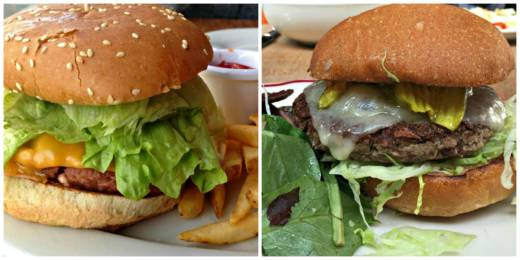The veggie burger was invented in 1982, a mix of dehydrated wheat gluten, sesame, soy and oats. It was an instant hit. The influential anti-meat treatise Diet For A Small Planet had come out a decade earlier, and people were ready for easy ways to eat less meat. The only problem? The veggie burger’s creator, a lifelong vegetarian, had never eaten a burger. His burger set the precedent of veggie burgers that resembled meat patties in shape only, and did little to mimic the taste or complexity of meat. Over the years, veggie burger behemoths like Boca Burger, Gardenburger and MorningStar (now available at a Burger King near you!) have tweaked their recipes, but their burgers--usually limp, evenly dirt-brown patties with an oddly chewy texture--still remain more of a concession than an epicurean delight, a product that has cornered the market so definitively that they don’t need to improve.
Recently, two veggie burgers have debuted in the Bay Area that reject that mold. Instead of modeling themselves after veggie burgers currently on the market, they promise hyperrealistic vegetarian burgers that look, taste and bleed like beef.

You’ve probably heard of the Impossible Burger, a plant-based burger that touts its ability to bleed like meat, blessed by people like Bill Gates and David Chang. The burger is the culmination of five years of work, a project spearheaded by Pat Brown, a former Stanford professor who wanted to figure out a way to combat the environmental problems of meat production. He set out to make a burger that was so realistically meat-like, people wouldn’t care that it was vegetarian. His team deconstructed the components that make meat so tasty, and found meat-free alternatives that give the same effect. The burger combines wheat protein, potato protein, coconut oil, and heme: an iron-rich compound that makes meat taste like meat. It also helps give blood its color.
The Impossible Burger is currently only available at a few restaurants in LA, New York and San Francisco. In SF, it’s available at Cockscomb for lunch and Jardinière for dinner. (The company’s goal is to eventually make it cheap enough to be sold in grocery stores). On my visit to Cockscomb, there was a palatable excitement for the $19 burger. Most of the tables had ordered the burger, which comes out topped with a jaunty little flag, and the table next to me talked about how they had been following the company from the start. The burger’s looks and texture are spot on: this could be any $20 San Francisco burger. It’s gray in places, pink in others, with crisp caramelized edges. The coconut oil gives it a satisfying juiciness that recalls burger grease. The flavor was savory and salty, but still had a slight tang to it (most likely from the heme, which they extract from yeast).

But even with that subtle offness, it’s nearly impossible to tell the difference, especially with a heap of strongly-flavored add-ons, including Dijon, pickles, caramelized onions and Gruyere. Is it worth the $19 and needing to make reservations? Yes, it’s an impressive, slightly bizarre novelty worth experiencing. It’s a mini-triumph in the man versus nature battle, carefully plated and served with a side salad.

Veggie Grill’s VG Beyond Burger aims to be the accessible Impossible Burger. The $12.95 burger, developed by Beyond Meat--which boasts investments from Tyson and General Mills and whose founder, Ethan Brown grew visiting his father's farm--is available at the vegan West Coast fast casual chain’s 28 locations, and the “burger” patties themselves are available at Whole Foods locations across the country--where they’re shelved in the meat section. (Of course, accessible is relative. Veggie Grill is considerably more expensive than your average fast food restaurant, and its restaurants are only located in tony suburbs like Corte Madera and Walnut Creek.) It’s made primarily from pea protein, and like the Impossible Burger, it promises blood, this time from beet juice.

My main tasting note was “Boca-esque” but it’s moister and more juicy than the dry, soy-based Boca. (It didn’t really bleed, either, but the patty was pink-ish). If the Impossible Burger resembles a pricy bistro burger, the Beyond Burger, with its grilled onions, a tangy sauce, and a slice of American-tasting vegan cheese, is more akin to a vegetarian In-N-Out burger (was there ever a more stereotypically Californian dish?) Your impression of it depends on the context. Are you a lifelong vegetarian, used to freezer case veggie burgers? You’re likely to be more impressed than your average meat eater--but it is definitely more satisfying than other fast food vegetarian options.

The fanfare that’s surrounded these burgers begs a series of increasingly philosophical questions: If you’re someone offended by GMOs, would you still eat these lab-made, hyper-processed burgers? What makes a good veggie burger? Is it simply supposed to be a vegetarian version of a burger, with the same decadent reputation, or is it supposed to be a healthy dish? Should it resemble meat, or should it just be a vegetarian patty that tastes good? Should millions of R&D dollars be spent on working on the problems of food access in low-income communities instead of debates on whether using wheat or pea protein is the best way to mimic beef? Or are veggie burgers the best and simplest way for Americans to eat less meat and cause less harm to the environment?
